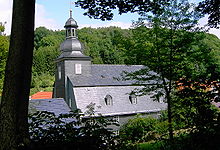Goldlauter-Heidersbach
|
Goldlauter-Heidersbach
City of Suhl
|
|
|---|---|
| Coordinates: 50 ° 38 ′ 10 ″ N , 10 ° 44 ′ 4 ″ E | |
| Height : | 530–610 m above sea level NN |
| Residents : | 2546 (Jan 31, 2015) |
| Incorporation : | April 1, 1979 |
| Postal code : | 98528 |
| Area code : | 03681 |
|
Location of Goldlauter-Heidersbach in Suhl
|
|

Goldlauter-Heidersbach is a district of the city of Suhl , located on the southern slope of the Thuringian Forest . Together with Heidersbach, Goldlauter has just over 2500 inhabitants.
location
The place is at the foot of the Großer Beerberg (982 m) near the towns of Zella-Mehlis and Oberhof . Goldlauter is located on the Lauter , a tributary of the Hazel , into which the Lauter drought and the Lange Lauter flow in the village. Goldlauter was spatially clearly separated from Heidersbach until the beginning of the 1990s, both districts have now grown together in terms of urban planning thanks to the new residential area of Breites Feld .
history
In 1519 Georg Emes reported for the first time to Count Wilhelm IV von Henneberg about minable silver deposits in the area. In 1546 the place was founded by the decree of the mountain freedom for Goldlauter by Wilhelm IV. Count and Lord zu Henneberg. The 450th anniversary of Goldlauter took place in 1996.
In the winter of 1694 there was a great famine in Goldlauter, from which most of the residents died. The need was alleviated with the support of Duke Moritz Wilhelm von Sachsen-Zeitz and Elector Johann Georg IV. Von Sachsen .
Heidersbach was founded at the request of four young residents of Goldlauter, who could not find their own apartment there due to overpopulation and therefore submitted the proposal to the supervisor in Schleusingen on February 4, 1706, instead of going out of the country between Goldlauter and Zella at a place that was known small Heiderbach or Ruhestadt calls to found a new village in the office of Suhl . The four applicants were the copper engraver Johann Nicol Stockmar, the charcoal burner Johann Georg Amarell, the woodcutter Johann Kummer and the grinder as well as the pipe smith Hans Storch. On March 3, 1706, the two charcoal-burners Caspar Schneider and Stephan Jung called Gering joined the request. The supervisor of Beust passed the requests on to the sovereign, Duke Moritz Wilhelm von Sachsen-Zeitz. On April 8, 1706, he approved the establishment of the new place with the condition that it be called Heidersbach from then on .
In 1815 there were 351 residents in Heidersbach and 1194 in Goldlauter.
The place owes its origin to the mining of silver and copper. Even today, field names bear witness to Goldlauter's past anchored in mining: Pochwerksgrund and Eisenberg (partly belonging to Schmiedefeld ).
In the 1920s and 1930s there were local groups of the FAUD and the SAJD in Goldlauter-Heidersbach . The latter organized its 2nd Reich holiday camp here in May 1931.
Goldlauter and Heidersbach were merged on April 1, 1938 to form the municipality of Goldlauter-Heidersbach. This was incorporated into the city of Suhl on April 1, 1979. Goldlauter had the postal code 6051 until 1993 , since then Goldlauter with the postal code 98528 is also part of the city of Suhl.
The Goldlauter correctional facility has been located in Goldlauter since 1991 .
tourism
The following are particularly attractive for tourism:
- Church in the Goldlauter district with organ brochure by Johann Michael Wagner
- Forest pool in Heidersbach (spring water basin)
- Airfield ( ICAO code EDQS, powered flight, glider flight, ultralight, coordinates: 50 ° 37 ′ 55 ″ N , 10 ° 43 ′ 39 ″ E )
- Alpine ski slope in the Langen Lauter, one of the most demanding slopes in Thuringia
- Ski stadium with illuminated cross-country ski run and ski jump as well as a large network of cross-country ski trails in the area
- Numerous hiking trails, including the mining trail with reconstructed tunnel entrances in the Pochwerkgrund
- Valleys partially or entirely in the Vessertal-Thuringian Forest biosphere reserve
Personalities
- Ernst Anschütz (1780–1861), teacher, organist, poet and composer of well-known folk and children's songs
- Reinhold Kleinlein (1883–1944), resistance fighter during the Nazi era
- Albert Kehr (1890–1979), local poet
- Cuno Werner (1925–2004), 29-time GDR champion in Nordic combined
Web links
Individual evidence
- ↑ http://www.oocities.org/syndikalismus_im_laendle/Liste.pdf
- ↑ Archived copy ( Memento of the original from May 31, 2011 in the Internet Archive ) Info: The archive link was inserted automatically and has not yet been checked. Please check the original and archive link according to the instructions and then remove this notice.



